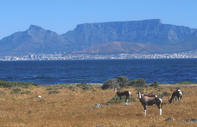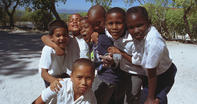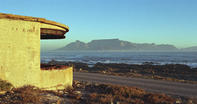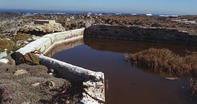Real Nature on the Island
The best way to experience the real nature of the Robben Island is to walk it. I was lucky enough to be given the opportunity to do this for myself, and I can honestly say that my walk around the island’s perimeter was one of the most rewarding hikes of my life.

What follows, then, is a brief description of that walk. A complete circuit around the island is about 12kms and it took me about 4 hours to complete, at a leisurely walking pace. The island’s perimeter is totally flat and, apart from the hot sun, it is an easy and fulfilling stroll. The quiet streets and houses, only half inhabited, bake in the sun as the scattered residents walk to and fro.
There are very few private cars on the island, and regular staff-shuttles transport people around the island. There are currently about 150 people living on the island, and they form a vibrant and fully-functioning community. There is a local organisation to represent the locals (RIVA – Robben Island Village Association), and there is even an bi-monthly island newsletter, called The Lighthouse.
Kids Living on the Island

It is rather surprising to see how many kids live on the Robben Island. Allice, who was my host, has two young children, and she told me that it’s a great environment in which to raise kids. It’s safe. It’s sheltered from the urban decay of the modern world. And it’s well-equipped with sports facilities, a crèche and a canteen (which locals still call The Mess).
The school yard is a noisy, happy place, and the local swimming pool (complete with lifeguard) is always busy. It must be quite lonely, however, and rather insular – as any small community is bound to be.
However, at night, when the wind starts to howl, the island changes its face and becomes downright spooky. One of the local kids even tried to scare me with stories of ghosts that roam the dark streets. I totally believed him. If there’s anyplace on Earth that is haunted by the phantoms of the past, it must be Robben Island. That evening, as I lay in bed, alone in the guest house, I thought that I could hear the restless movement of someone standing outside my window...
Beyond the village

Beyond the village, the first thing that strikes you is the view. There, across the channel, stands Table Mountain and all its brethren, resplendent in their glorious majesty. They seem so close, yet so far.
This illusory proximity to Cape Town must have been torture for the prisoners. This southern edge of the island is covered by the bus trip, but you can’t really appreciate the vista unless you slow down and drink in the scenery. I took full advantage of this luxury as I explored the Alpha One outpost, the Fong Chung shipwreck, the ruined army barracks, the abandoned WWII lookouts, and Van Riebeeck’s old quarry (now filled with green water and frequented by water birds).
As you continue past the point where the bus turns away from the coast and up towards the lighthouse, you leave the ‘civilised’ part of the island behind and enter the wildness of the north-western shore. Here, nature has been allowed to take over, and the only sign of human interference in the narrow gravel road that leads along the serrated coast.
The sound of the sea fills your senses, as sea birds gather in ever-increasing numbers on the jagged rocks. Buck graze quietly in the tall grass on the road side and your solitude is total. But the walk is never boring.
From this vantage point, you can look right down the coast of the mainland: from the City Bowl to Sea Point, on to Camps Bay, along the Twelve Apostles to Hout Bay and Chapman’s Peak – a view you simply can’t get from any other place on Earth.
Landing Strip

A short distance further along is a small boat house and the long-abandoned Baths of Bethesda, the tidal pool where the lepers used to bathe in the ‘curative’ cold sea-water. The island’s landing strip now lies hidden behind a line of Bluegum trees to the right, as the sea keeps up its constant vigil to the left. Ahead of you is only the open ocean.
The silence is deafening. Near the top of the island, you come to the old slate quarry, where many of the island’s prisoners were subjected to back-breaking labour and spirit-breaking abuse. Mounds of broken stone, piled into rough hills, stand alongside the quarry, an eloquent testimony to the futile labour of previous inmates.
On the north-eastern side of the island, the penguins take over. And there are thousands of the little beggars. Since humans are not a common sight on this part of the shore, the penguins are in their element. They throng along the water’s edge, standing at attention on the rocks and splashing in the waves.
There are also several WW2 outlooks on this part of the island, keeping their empty vigil over the Blouberg channel, as huge freighters cut through the intervening strait on their way to the Cape Town harbour. An old military observation tower is clearly visible over the tops of the trees.
This part of the island was also the location of several leper villages, but no evidence of these settlements remains. From here, it is a short stroll back to the harbour and the maximum security jail. The island walk only takes a few hours, but it incorporates over 500 years of history and a pristine natural environment that really nourishes the soul. It will take your breath away.
By David Fleminger